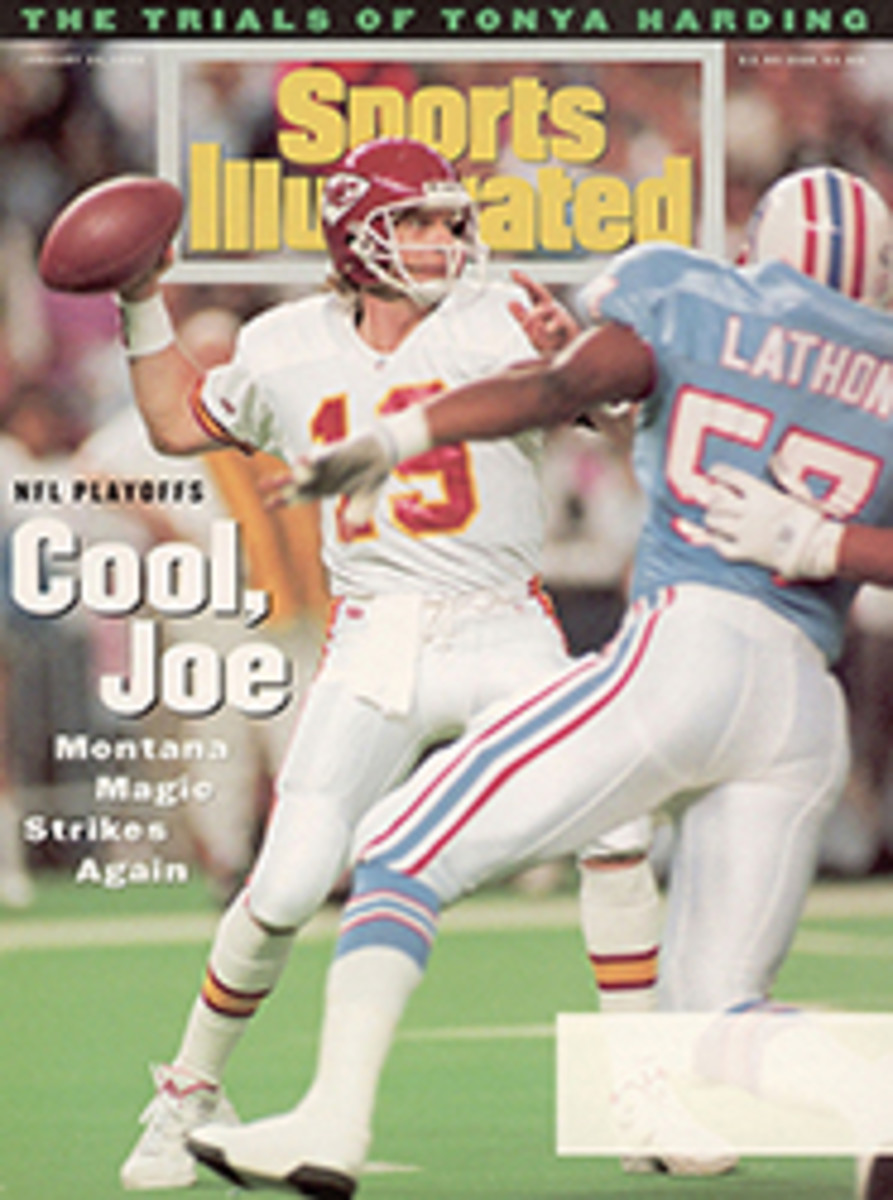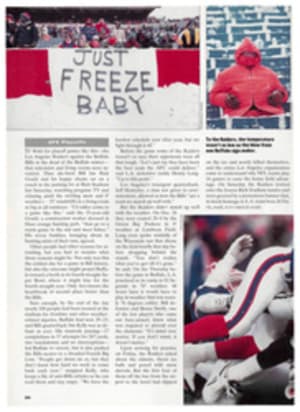
A Hair-Raising Hero
HIS HAIR. That's the first thing people notice about Glen Plake. His hair is at the root of his fame, and his infamy, and it is one of the reasons Plake has become the most recognizable skier in North America. As he signs autographs at a ski-industry trade show in Las Vegas, his hair, as it usually does for his public appearances, stands atop his head in a 15-inch-high, bleached-blond Mohawk. Today, though, Plake has added crimson streaks to the top few inches of hair and tinted the bottom third brown so that his coiffure resembles the dorsal fin of a brightly colored tropical fish. The rest of his head is shaved smooth.
"I haven't cut my Mohawk since I was 17," says Plake, now 29. "Each time I gel it up, it's a little different. When my 'hawk is up, I feel a lot more self-confident; with it up, anything can go."
In the last few years just about everything has. Plake is the American ringleader of the relatively new sport of extreme skiing. Born in the French Alps in the late '30s and refined there in the '60s, the sport entails climbing the steepest mountains imaginable, then skiing down them. Extreme skiing is not in itself a money-making sport, but if you're good enough at it, you can perform in ski movies. If you're filmed enough times, sponsors will pay you to use their products. At best, it's a tenuous, and not particularly sensible, way to make a living; more extreme skiers end their career with broken limbs, or worse, than with money in the bank.
Without doubt Plake is a dazzling skier. He flies off 30-foot cliffs with a ballet dancer's grace; he skis nearly vertical gullies like a spider darting down a wall; he hurtles down mountains at 70 mph without showing so much as a flicker of panic. Yet there are perhaps a dozen skiers in North America with talent similar to Plake's. None, however, earns a fraction of the money Plake makes or enjoys even a modicum of his celebrity. That's because no one else in the ski community matches his charisma, his effervescence or his ability to draw a crowd. And, of course, no one else has a 15-inch-high Mohawk.
One glance around the ski show and it's obvious that Plake is without peer. Throughout the cavernous Las Vegas Convention Center are banners and posters and promotional materials bearing his likeness; his face is ubiquitous, making it appear as if he is the only person at the show who actually skis. Between autograph-signing sessions he walks to each of his sponsors' booths, taking long, loping strides, like a surfer at the beach. Most of the show's attendees are wearing conservative business attire; Plake is in blue-soled flip-flops, knee-length Hawaiian-print shorts and a white T-shirt. His right leg is spider-webbed with scars—he has broken it three times—and his skin bears a skier's deep, uneven tan. He is only 5'10", but because of his hair, he appears taller than anyone else in the room.
Product designers constantly rush up to Plake, asking him to give their wares a try, knowing that if he uses them—and is photographed doing so—hordes of adolescent skiers will rush out and buy them. Plake gives all the designers his full attention, speaking in a raspy California drawl and often breaking into great spasms of laughter. He has a world-class laugh. It begins as a mere look—a smirk, really—before building to a jackhammer ha, ha, Ha, HA, HA! Meanwhile Plake throws back his head, closes his eyes and scrunches his nose. As he winds up this startling routine, everyone around him is laughing too.
When Plake returns to his booth to continue signing autographs, the line stretches halfway across the room—this, despite the fact that he has never competed in an Olympic event. "People have a hard time relating to racers; it's a fabricated form of skiing," he says, attempting to explain his popularity. "My skiing, in a subdued way, is done by skiers every time they hit the slopes." Doug Warbrick, co-founder of Rip Curl skiwear, whose ads and brochures feature Plake, has another theory: "Glen Plake is an all-American folk hero."
Plake's rise to stardom is indeed the stuff of legend. He grew up in South Lake Tahoe, Calif.; lived with his mother, Carolyn (his parents divorced when he was two); and skied on the race team at nearby Heavenly Valley ski resort. He was obviously talented, but at the same time he was stubbornly independent—rules do not sit well with Plake—and he was booted off the team at 15. "Ever since I was six or seven," he says, "all I really wanted to do was ski down a hill and have everybody say, 'There goes Glen.' "
To achieve this goal Plake skied constantly, to the exclusion of academics: He dropped out of high school after his sophomore year. His flamboyance was more suited to the burgeoning sport of mogul skiing, or hotdogging, as it used to be called, and he was ranked as high as 10th in the nation in 1985. But moguling, too, had specific rules, and his differences with the U.S. Ski Team led to his departure from the team the same year. He was 21 years old and penniless—"I qualified for welfare," he says—when, in 1986, he learned that ski filmmaker Greg Stump would be shooting his next movie at an area near Plake's home in California's Squaw Valley.
Uninvited, Plake showed up at the filming site and strutted his stuff. He outskied the members of Stump's cast, and a few minutes of his performance ended up in the movie. His personality, his hairdo and his fun-at-all-costs style combined to create a mesmerizing on-screen presence. The next winter Stump cast Plake in his film The Blizzard of Aahhh's.
Blizzard, released in 1988, is widely regarded as one of the alltime great gonzo ski movies, and Plake is its undisputed star. His 98-mph schuss while wearing a helmet-mounted camera, his enormous cliff jumps, his granny sunglasses and his electric laughter were an inspiration to every hard-luck ski bum in North America, as well as to dozens of companies wanting to sell gear to those very same ski bums. Plake's career was launched.
More than eight years and a handful of movies later, he is as popular as ever. He has multiyear endorsement deals with half a dozen ski-equipment manufacturers (his father, Jim, 49, serves as his agent); he owns nine cars, two boats and two houses; he married a fashion model, Kimberly Manuel, in 1991. He skis more than 200 days each year, flying around the world to appear at various ski-related events. He is invited to speak at dozens of high school graduations.
And yet he hasn't lost touch with his ski-bum roots. In December 1991, Glen and Kimberly embarked on the Down Home Tour, a 68-day, 13,000-mile road trip around the U.S., visiting ski areas, large and small, in 33 states. "It was a big thank-you note to everyone who's helped me out," says Plake, whose appearance created a mob scene wherever he skied. "Instead of just signing posters, I wanted to get out and ski with everyone. And my fans don't live in Aspen—they live in all the out-of-the-way places across the U.S."
Still, Plake is not without detractors. Some people in the ski industry say he projects a wild and dangerous image. Others claim his bad-boy persona is just an act. A few say that beneath his flashy hairdo, he's not really a great skier—cut off the Mohawk, they say, and Plake's finished.
"Anyone who knocks my skiing has never skied with me," says Plake, rebutting his critics. "If they don't like my personality, that's their choice—I'm not in love with everybody in the world, either. As for the Mohawk, well, the thing does start itching after a while. And sometimes in the morning when I'm about to put it up [the process takes 20 minutes], I think about cutting it off. But that thought has never lasted for more than a moment."
PHOTO
LARRY PROSOR
Kicked off a ski team at 15 for insubordination, Plake now earns a bundle for doing as he pleases.
TWO PHOTOS
LARRY PROSOR
Other skiers may be as talented as Plake, but sponsors like him for his charm and, of course, his 'do.
Michael Finkel lives in Bozeman, Mont., and writes often on skiing and other winter sports.

